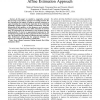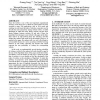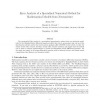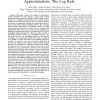245 search results - page 10 / 49 » Second Order Approximations for Probability Models |
GLOBECOM
2008
IEEE
13 years 7 months ago
2008
IEEE
In this paper we consider a cooperative network that is trying to reach binary consensus over fading channels. We first characterize the impact of fading on network consensus by up...
SIGIR
2006
ACM
14 years 1 months ago
2006
ACM
Since the website is one of the most important organizational structures of the Web, how to effectively rank websites has been essential to many Web applications, such as Web sear...
QEST
2008
IEEE
14 years 1 months ago
2008
IEEE
In [3] a probabilistic semantics for timed automata has been defined in order to rule out unlikely (sequences of) events. The qualitative model-checking problem for LTL propertie...
AMC
2006
13 years 7 months ago
2006
The exponential Euler method is a nonstandard approximation scheme that was developed specifically for the Hodgkin-Huxley differential equation models that arise in neuroscience a...
INFOCOM
2009
IEEE
14 years 2 months ago
2009
IEEE
—This paper considers the design of opportunistic packet schedulers for users sharing a time-varying wireless channel from the performance and the robustness points of view. Firs...




